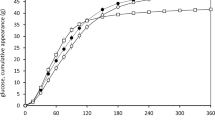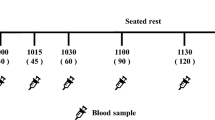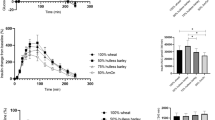Abstract
Background:
Studies suggest that honey has less influence on serum glucose concentrations than monosaccharides and disaccharides. Previous studies, however, have only analysed glucose metabolism.
Methods:
This study investigated the influence of two types of honey (rapeseed and acacia) on the serum levels of glucose, fructose, insulin and C-peptide values in healthy subjects. The results were compared with honey-comparable glucose–fructose solutions. All solutions contained 75 g of glucose and/or fructose.
Results:
We found significantly higher fructose serum levels with rapeseed honey after 2 h but no such differences for acacia honey. C-peptide levels were significantly higher after administration of both honeys after 1 and 2 h.
Conclusions:
For the first time it has been found out that honey ingestion leads to a rise of blood fructose concentration: in one case, this rise was lower than that achieved after fructose/glucose controls, in the other cases it was same as after the controls. Fructose metabolism may be inhibited by unidentified substances present in the rapeseed honey. Further study to elucidate underlying mechanisms may be worthwhile, as usually there is no differentiation between the different types of honey.
This is a preview of subscription content, access via your institution
Access options
Subscribe to this journal
Receive 12 print issues and online access
$259.00 per year
only $21.58 per issue
Buy this article
- Purchase on Springer Link
- Instant access to full article PDF
Prices may be subject to local taxes which are calculated during checkout
Similar content being viewed by others
References
Agrawal OP, Pachauri A, Yadav H, Urmila J, Goswamy HM, Chapperwal A et al. (2007). Subjects with impaired glucose tolerance exhibit a high degree of tolerance to honey. J Med Food 10, 473–478.
Ahmad A, Azim MK, Mesaik MA, Khan RA (2008). Natural honey modulates physiological glycemic response compared to simulated honey and D-glucose. J Food Sci 73, H165–H167.
Al-Waili NS (2004). Natural honey lowers plasma glucose, C-reactive protein, homocysteine, and blood lipids in healthy, diabetic, and hyperlipidemic subjects: comparison with dextrose and sucrose. J Med Food 7, 100–107.
American Diabetes Association (2006). Standards of medical care in diabetes—2006. Diabetes Care 29 (Suppl 1), S4–S42.
Bornet F, Haardt MJ, Costagliola D, Blayo A, Slama G (1985). Sucrose or honey at breakfast have no additional acute hyperglycaemic effect over an isoglucidic amount of bread in type 2 diabetic patients. Diabetologia 28, 213–217.
Katsilambros NL, Philippides P, Touliatou A, Georgakopoulos K, Kofotzouli L, Frangaki D et al. (1988). Metabolic effects of honey (alone or combined with other foods) in type II diabetics. Acta Diabetol Lat 25, 197–203.
Münstedt K, Bargello M, Hauenschild A (2009a). Royal jelly and its influence on serum fructose and serum lipids. J ApiProduct ApiMedical Sci 1, 90–91.
Münstedt K, Hoffmann S, Hauenschild A, Bülte M, von Georgi R, Hackethal A (2009b). Effect of honey on serum cholesterol and lipid values. J Med Food 12, 624–628.
Münstedt K, Sheybani B, Hauenschild A, Brüggmann D, Bretzel RG, Winter D (2008). Effects of basswood honey, honey-comparable glucose-fructose solution, and oral glucose tolerance test solution on serum insulin, glucose, and C-peptide concentrations in healthy subjects. J Med Food 11, 424–428.
Oizumi T, Daimon M, Jimbu Y, Kameda W, Arawaka N, Yamaguchi H et al. (2007). A palatinose-based balanced formula improves glucose tolerance, serum free fatty acid levels and body fat composition. Tohoku J Exp Med 212, 91–99.
Schaefer EJ, Gleason JA, Dansinger ML (2009). Dietary fructose and glucose differentially affect lipid and glucose homeostasis. J Nutr 139, 1257S–1262S.
Acknowledgements
The authors thank the volunteers for their assistance and acknowledge the support of a grant from Stiftung Dr Abel–Apis mellifica, Germany.
Author information
Authors and Affiliations
Corresponding author
Ethics declarations
Competing interests
The authors no declare conflict of interest.
Rights and permissions
About this article
Cite this article
Münstedt, K., Böhme, M., Hauenschild, A. et al. Consumption of rapeseed honey leads to higher serum fructose levels compared with analogue glucose/fructose solutions. Eur J Clin Nutr 65, 77–80 (2011). https://doi.org/10.1038/ejcn.2010.186
Received:
Revised:
Accepted:
Published:
Issue Date:
DOI: https://doi.org/10.1038/ejcn.2010.186
Keywords
This article is cited by
-
DNA methylation during human adipogenesis and the impact of fructose
Genes & Nutrition (2020)
-
Short-term effects of six Greek honey varieties on glycemic response: a randomized clinical trial in healthy subjects
European Journal of Clinical Nutrition (2018)
-
Cardiovascular responses to sugary drinks in humans: galactose presents milder cardiac effects than glucose or fructose
European Journal of Nutrition (2017)
-
Metabolic fate of fructose in human adipocytes: a targeted 13C tracer fate association study
Metabolomics (2015)



